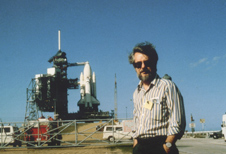
Jim Slade
Science Correspondent, ABC Television and Radio
As its science correspondent, Jim Slade led coverage of space, science and technology issues for ABC Television and Radio News from 1988 through 2001. He worked in a similar capacity at the Mutual Broadcasting System (1976 to 1988) and the Westinghouse Broadcasting Company (1961 to 1976), a career which allowed him to witness the first 40 years of world spaceflight first hand. As a science writer, his stories ranged from exploration to education, archaeology to high-speed computers.
Slade’s lifelong interest in aviation kept him at the forefront of some of the most exciting technological developments of the 20th and 21st centuries. He covered NASA spaceflight from the time humans were first launched in the early 1960s. Along the way, he reported development work done by the X-15 rocket ship, the unveiling of the SR71 Blackbird spy plane, Mercury, Gemini, Apollo, Skylab, the space shuttle, the Russian Mir and the International Space Station.
One of forty journalists chosen by his peers to be considered for a flight on the shuttle, Slade was also honored by the Aviation/Space Writer’s Association for his coverage of efforts to preserve “Aging Airliners,” for his coverage of the Voyager interplanetary space missions, by the Ohio State Awards Committee for his coverage of the X-15, by the Associated Press for his reporting on Apollo, and by TWA for covering airline economic issues. In 1991, the National Space Club honored Slade as its “Journalist of the Year.” He was officially recognized as one of the American space program “Chroniclers” in the mid-1990s.
In other fields of science and technology, Slade wrote extensively on computer science, coal technology, nuclear and solar power, transportation, and covered the early geological and environmental surveys, which lead to construction of the Alaskan oil pipeline.
Before joining ABC News in 1988 – and between space operations – Slade covered the Carter White House and Reagan State Department for the Mutual Broadcasting System. During those years, he reported from virtually every country in Western Europe and from some in the eastern sector. While traveling with the Secretary of State George Shultz, Slade worked extensively in the Soviet Union, reporting often from Moscow during the period in which groundwork was laid for the end of the Cold War. He also worked frequently in the Middle East, including Jordan, Syria, Saudi Arabia, Egypt and Israel.
Additionally, Slade was the first radio correspondent to land on Grenada during the U.S. invasion.
Although he has written extensively for aviationand space magazines about airplanes spacecraft and the people who fly them, his first book took most people by surprise. Having nothing to do with modern flight, “Firestorm at Getysburg” is a compilation of first person narratives by the citizens of Gettysburg, Pa., that remained in their homes during the pivotal event of the Civil War. The battle virtually was fought on their doorsteps from July 1 through July 3, 1863. Slade and his partner, John Alexander, gathered the material over a 20-year period.
Slade began his broadcasting career in Morgantown, W.Va., in 1954 at radio station WCLG, moving to WPDX, Clarksburg, and back to Morgantown for two stints ar WAJR, sandwiching television work at WTRF-TV, Wheeling, W.Va., between those tours.
He received his first “big break” in 1961 at WOWO, the Westinghouse Broadcasting Company’s 50-thousand watt station in Ft. Wayne, Indiana. Two years later, Westinghouse transferred him to its Chicago station, WIND, where he eventually was named news director. His last year at WIND included directing coverage of the riotous Democratic National Convention of 1968, the assassinations of Martin Luther King Jr. and Robert F. Kennedy, the primaries, election and several major spaceflights. Slade was transferred to the company’s Washington news bureau the next year.
When the Westinghouse bureau was closed in 1976, Slade worked for three years in the news division of ABC’s radio station WMAL before accepting a position with the Mutual Broadcasting System in 1979. He moved to ABC in 1988.
Slade is a “pen name given Mr. Snyder when he joined Westinghouse in 1961. Having no choice in the matter, he was dubbed “Slade” because one of the company’s senior correspondents also was named James Snyder. The name stuck as a fortunate trademark.
He and his wife, Mary Alice, are natives of Margantown, W.Va., now living in McLean, Va. The Snyder’s have two sons: Jeff, a writer and editor in Philadelphia, and Marc, a professional artist who works in Hamden, Conn. They have two grandchildren, Michael and Madeline, who, needless to say, are the true “stars” of the Snyder show.






















